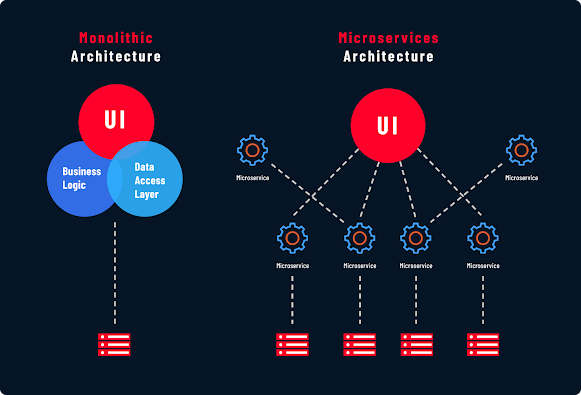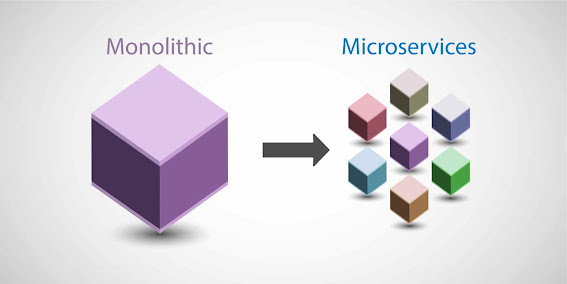Hello guys, if you are preparing for Microservice developer interview or just a JAva developer interview where Microservices skills are needed then you must prepare with the difference between Monolithic and Microservices articles. It's one of the popular Microservices interview questions and often asked on both face-to-face round of interview or telephonic interviews. Microservices and monolithic architectures are two of the most common approaches to building software systems. While both approaches have their benefits and drawbacks, they differ significantly in terms of their architecture, development, deployment, and maintenance.
In this article, we will explore the key differences between microservices and monolithic architecture and the factors that should be considered when deciding which approach to use.
In this article, we will explore the key differences between microservices and monolithic architecture and the factors that should be considered when deciding which approach to use.
What is Monolithic Architecture?
Monolithic architecture is a traditional approach to building software systems where all the components of the system are tightly coupled and run on a single platform. In this approach, the system is built as a single, self-contained unit that includes the user interface, business logic, and data access layers.
Difference Between Microservices and Monolithic Architecture
Monolithic architecture is usually developed using a single programming language and a single database management system. All changes and updates to the system are made in one codebase, which is then deployed as a single application.
What are Microservices?
Microservices, on the other hand, is an approach to building software systems where the system is broken down into smaller, independent services that are loosely coupled and communicate with each other using APIs. In this approach, each service is developed and deployed independently of the others.
In a microservices architecture, each service is responsible for a specific business function, and each service can be developed using a different programming language and a different database management system. This allows developers to choose the best technology for each service.
Differences between Monolithic Architecture and Microservices
Now that you know what is Monolithic and what is Microservices, it times to learn about difference between these two architecture choices:
1. Architecture
Monolithic architecture is characterized by a single, tightly coupled architecture that includes all components of the system. All the functions and services of the application are contained within a single codebase, making it easier to develop, test, and deploy. However, this approach can lead to scalability and maintenance issues as the application grows in size and complexity.
In contrast, microservices architecture is characterized by a modular, loosely coupled architecture. Each service is developed and deployed independently of the others, allowing for greater flexibility and scalability. The modular architecture also makes it easier to update or replace individual services without affecting the entire system.
2. Development
In a monolithic architecture, all the code is written in a single programming language and deployed as a single application. This approach can simplify development as all the code is located in one place, but it can also make it difficult to maintain and scale the application as it grows.
In a microservices architecture, developers can use different programming languages and technologies for each service. This approach allows developers to choose the best technology for each service, making it easier to scale and maintain the system over time.
3. Deployment
In a monolithic architecture, the entire application is deployed as a single unit. This approach can simplify deployment but can also make it more difficult to update the application as it requires the entire application to be redeployed.
In a microservices architecture, each service can be deployed independently of the others. This approach allows for greater flexibility in deployment and makes it easier to update individual services without affecting the entire system.
4. Maintenance
In a monolithic architecture, maintenance can be challenging as all the code is located in a single codebase. This can make it difficult to update or replace individual components without affecting the entire application.
In a microservices architecture, each service can be updated or replaced independently of the others, making maintenance easier and less disruptive to the system.
When deciding which approach to use, it's important to consider ;
5. Size and complexity of the application:
Monolithic architecture is often a better choice for smaller and less complex applications, while microservices architecture is more suitable for larger and more complex applications. If the application is small and unlikely to grow, monolithic architecture may be a better choice as it is simpler and easier to develop and maintain. If the application is expected to grow and become more complex over time, microservices architecture may be a better choice as it allows for greater flexibility and scalability.
6. Team size and expertise:
The size and expertise of the development team can also influence the choice between monolithic and microservices architecture. If the development team is small and lacks expertise in multiple programming languages and technologies, monolithic architecture may be a better choice as it is simpler and easier to develop.
If the development team is large and has expertise in multiple programming languages and technologies, microservices architecture may be a better choice as it allows for greater flexibility and the ability to choose the best technology for each service.
7. Performance and scalability:
If performance and scalability are critical factors for the application, microservices architecture may be a better choice. Microservices allow for greater scalability and performance as each service can be scaled independently. In contrast, monolithic architecture may become a bottleneck as the entire application is deployed as a single unit.
8. Cost
The cost of development, deployment, and maintenance can also influence the choice between monolithic and microservices architecture. Monolithic architecture is simpler and less complex, making it less expensive to develop and maintain. However, if the application is expected to grow and become more complex over time, the cost of maintaining a monolithic architecture may increase.
Microservices architecture, on the other hand, is more complex and requires more effort to develop and maintain, making it more expensive in the short term. However, it may be more cost-effective in the long run as it allows for greater flexibility and scalability.
Conclusion
Both monolithic architecture and microservices have their benefits and drawbacks, and the choice between them depends on the specific needs of the application. Monolithic architecture is simpler to develop and deploy but can lead to scalability and maintenance issues as the application grows in size and complexity. Microservices architecture, on the other hand, offers greater flexibility and scalability but can be more complex to develop and deploy.
In conclusion, the choice between monolithic and microservices architecture depends on several factors, including the size and complexity of the application, the size and expertise of the development team, performance and scalability requirements, and cost.
Both approaches have their benefits and drawbacks, and the decision should be based on a careful evaluation of these factors. Ultimately, the key to success is to choose an architecture that is flexible, scalable, and easy to maintain over time.














No comments :
Post a Comment